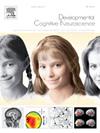Encoding models for developmental cognitive computational neuroscience: Promise, challenges, and potential
IF 4.6
2区 医学
Q1 NEUROSCIENCES
引用次数: 0
Abstract
Cognitive computational neuroscience has received broad attention in recent years as an emerging area integrating cognitive science, neuroscience, and artificial intelligence. At the heart of this field, approaches using encoding models allow for explaining brain activity from latent and high-dimensional features, including artificial neural networks. With the notable exception of temporal response function models that are applied to electroencephalography, most prior studies have focused on adult subjects, making it difficult to capture how brain representations change with learning and development. Here, we argue that future developmental cognitive neuroscience studies would benefit from approaches relying on encoding models. We provide an overview of encoding models used in adult functional magnetic resonance imaging research. This research has notably used data with a small number of subjects, but with a large number of samples per subject. Studies using encoding models also generally require task-based neuroimaging data. Though these represent challenges for developmental studies, we argue that these challenges may be overcome by using functional alignment techniques and naturalistic paradigms. These methods would facilitate encoding model analysis in developmental neuroimaging research, which may lead to important theoretical advances.
发展认知计算神经科学的编码模型:前景、挑战和潜力
认知计算神经科学作为融合认知科学、神经科学和人工智能的新兴领域,近年来受到广泛关注。作为这一领域的核心,使用编码模型的方法可以从潜在的高维特征(包括人工神经网络)来解释大脑活动。除了应用于脑电图的时间反应函数模型之外,之前的大多数研究都集中在成年受试者身上,因此很难捕捉到大脑表征是如何随着学习和发育而变化的。在此,我们认为未来的发育认知神经科学研究将受益于依赖编码模型的方法。我们概述了成人功能磁共振成像研究中使用的编码模型。这些研究主要使用少量受试者的数据,但每个受试者都有大量样本。使用编码模型的研究通常还需要基于任务的神经成像数据。虽然这些都是发展研究面临的挑战,但我们认为可以通过使用功能配准技术和自然范式来克服这些挑战。这些方法将促进发育神经影像研究中的编码模型分析,并可能带来重要的理论进展。
本文章由计算机程序翻译,如有差异,请以英文原文为准。
求助全文
约1分钟内获得全文
求助全文
来源期刊

Developmental Cognitive Neuroscience
NEUROSCIENCES-
CiteScore
7.60
自引率
10.60%
发文量
124
审稿时长
6-12 weeks
期刊介绍:
The journal publishes theoretical and research papers on cognitive brain development, from infancy through childhood and adolescence and into adulthood. It covers neurocognitive development and neurocognitive processing in both typical and atypical development, including social and affective aspects. Appropriate methodologies for the journal include, but are not limited to, functional neuroimaging (fMRI and MEG), electrophysiology (EEG and ERP), NIRS and transcranial magnetic stimulation, as well as other basic neuroscience approaches using cellular and animal models that directly address cognitive brain development, patient studies, case studies, post-mortem studies and pharmacological studies.
 求助内容:
求助内容: 应助结果提醒方式:
应助结果提醒方式:


